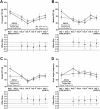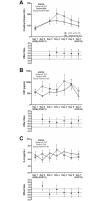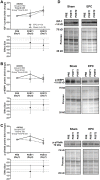Does external pneumatic compression treatment between bouts of overreaching resistance training sessions exert differential effects on molecular signaling and performance-related variables compared to passive recovery? An exploratory study
- PMID: 28662152
- PMCID: PMC5491247
- DOI: 10.1371/journal.pone.0180429
Does external pneumatic compression treatment between bouts of overreaching resistance training sessions exert differential effects on molecular signaling and performance-related variables compared to passive recovery? An exploratory study
Abstract
Purpose: We sought to compare the effects of external pneumatic compression (EPC) and sham when used concurrently with resistance training on performance-related outcomes and molecular measures related to recovery.
Methods: Twenty (N = 20) resistance-trained male participants (aged 21.6±2.4 years) were randomized to balanced sham or EPC intervention groups. The protocol consisted of 3 consecutive days of heavy, voluminous back squat exercise followed by EPC/sham treatment (Days2-4) and 3 consecutive days of recovery (Days5-7) with EPC/sham only on Days5-6. On Day1 (PRE), and Days3-7, venipuncture, flexibility and pressure-to-pain threshold (PPT) measures were performed. Vastsus lateralis muscle tissue was biopsied at PRE, 1-h post-EPC/sham treatment on Day2 (POST1) and 24-h post-EPC/sham treatment on Day7 (POST2). Isokinetic peak torque was assessed at PRE and POST2.
Results: Peak isokinetic strength did not change from PRE to POST2 in either group. The PPT was significantly lower on Days3-6 with sham, indicating greater muscle soreness, though this was largely abolished in the EPC group. A significant decrease in flexibility with sham was observed on Day3 (+16.2±4.6% knee joint angle; P<0.01) whereas there was no change with EPC (+2.8±3.8%; P>0.01). Vastus lateralis poly-ubiquitinated proteins significantly increased at the POST2 time point relative to PRE with sham (+66.6±24.6%; P<0.025) and were significantly greater (P<0.025) than those observed with EPC at the same time point (-18.6±8.5%). 4-hydroxynonenal values were significantly lower at POST2 relative to PRE with EPC (-16.2±5.6%; P<0.025) and were significantly lower (P<0.025) than those observed with sham at the same time point (+11.8±5.9%).
Conclusion: EPC mitigated a reduction in flexibility and PPT that occurred with sham. Moreover, EPC reduced select skeletal muscle oxidative stress and proteolysis markers during recovery from heavy resistance exercise.
Conflict of interest statement
Figures







References
-
- Gill ND, Beaven CM, Cook C. Effectiveness of post-match recovery strategies in rugby players. British journal of sports medicine. 2006;40(3):260–3. doi: 10.1136/bjsm.2005.022483 - DOI - PMC - PubMed
-
- Kraemer WJ, Bush JA, Wickham RB, Denegar CR, Gomez AL, Gotshalk LA, et al. Influence of compression therapy on symptoms following soft tissue injury from maximal eccentric exercise. J Orthop Sports Phys Ther. 2001;31(6):282–90. doi: 10.2519/jospt.2001.31.6.282 . - DOI - PubMed
-
- Berry MJ, Bailey SP, Simpkins LS, TeWinkle JA. The effects of elastic tights on the post-exercise response. Canadian journal of sport sciences = Journal canadien des sciences du sport. 1990;15(4):244–8. . - PubMed
-
- Duffield R, Cannon J, King M. The effects of compression garments on recovery of muscle performance following high-intensity sprint and plyometric exercise. Journal of science and medicine in sport / Sports Medicine Australia. 2010;13(1):136–40. doi: 10.1016/j.jsams.2008.10.006 . - DOI - PubMed
-
- Martin JS, Borges AR, Beck DT. Peripheral conduit and resistance artery function are improved following a single, 1-h bout of peristaltic pulse external pneumatic compression. Eur J Appl Physiol. 2015;115(9):2019–29. doi: 10.1007/s00421-015-3187-8 . - DOI - PubMed
MeSH terms
LinkOut - more resources
Full Text Sources
Other Literature Sources

